Reservoir-Induced Hydrological Alterations Using Ecologically Related Hydrologic Metrics: Case Study in the Beijiang River, China
Abstract
1. Introduction
2. Study Area and Data
2.1. Study Area
2.2. Data
3. Methodology
3.1. IHA Selection
3.2. Hydrological Alterations
3.3. Ecosurplus and Ecodeficit
3.4. Eco-Environmental Water Demand
4. Results
4.1. Ecological Variability
4.2. Analysis of IHA Indices
4.3. Eco-Environmental Water Demand
4.4. Comparison Between IHA-32 Indices and Eco-Flow Metrics
5. Discussion and Conclusions
Author Contributions
Funding
Acknowledgments
Conflicts of Interest
References
- Vörösmarty, C.J.; Green, P.; Salisbury, J.; Lammers, R.B. Global water resources: Vulnerability from climate change and population growth. Science 2000, 289, 284–288. [Google Scholar] [CrossRef] [PubMed]
- Li, J.; Wang, Z.; Lai, C. Severe drought events inducing large decrease of net primary productivity in mainland China during 1982–2015. Sci. Total Environ. 2019. [Google Scholar] [CrossRef]
- Li, J.; Wang, Z.; Lai, C.; Wu, X.; Zeng, Z.; Chen, X.; Lian, Y. Response of net primary production to land use and land cover change in mainland China since the late 1980s. Sci. Total Environ. 2018, 639, 237–247. [Google Scholar] [CrossRef]
- Wu, X.; Guo, S.; Yin, J.; Yang, G.; Zhong, Y.; Liu, D. On the event-based extreme precipitation across China: Time distribution patterns, trends, and return levels. J. Hydrol. 2018, 562, 305–317. [Google Scholar] [CrossRef]
- Li, J.; Wang, Z.; Wu, X.; Xu, C.; Guo, S.; Chen, X. Toward monitoring short-term droughts using a novel daily scale, standardized antecedent precipitation evapotranspiration index. J. Hydrometeorol. 2020, 21, 891–908. [Google Scholar] [CrossRef]
- Nilsson, C.; Reidy, C.A.; Dynesius, M.; Revenga, C. Fragmentation and flow regulation of the world’s large river systems. Science 2005, 308, 405–408. [Google Scholar] [CrossRef]
- Schwarzenbach, R.P.; Egli, T.; Hofstetter, T.B.; Gunten, U.; Wehrli, B. Global water pollution and human health. Annu. Rev. Environ. Resour. 2010, 35, 109–136. [Google Scholar] [CrossRef]
- Lian, Y.; You, J.; Sparks, R.; Demissie, M. Impact of human activities to hydrologic alterations on the Illinois River. J. Hydrol. Eng. 2012, 17, 537–546. [Google Scholar] [CrossRef]
- McManamay, R.A. Quantifying and generalizing hydrologic responses to dam regulation using a statistical modeling approach. J. Hydrol. 2014, 519, 1278–1296. [Google Scholar] [CrossRef]
- McDaniel, R.D.; O’Donnell, F.C. Assessment of hydrologic alteration metrics for detecting urbanization impacts. Water 2019, 11, 1017. [Google Scholar] [CrossRef]
- Panagopoulos, Y.; Stefanidis, K.; Sanchez, M.F.; Weiland, F.S.; Beek, R.V.; Venohr, M.; Globevnik, L.; Mimikou, M.; Birk, S. Pan-European calculation of hydrologic stress metrics in rivers: A first assessment with potential connections to ecological status. Water 2019, 11, 703. [Google Scholar] [CrossRef]
- Warner, R.F. Environmental impacts of hydroelectric power and other anthropogenic developments on the hydromorphology and ecology of the Durance channel and the Etang de Berre, southeast France. J. Environ. Manag. 2012, 104, 35–50. [Google Scholar] [CrossRef] [PubMed]
- Meißner, T.; Schutt, M.; Sures, B.; Feld, C.K. Riverine regime shifts through reservoir dams reveal options for ecological management. Ecol. Appl. 2018, 28, 1897–1908. [Google Scholar] [CrossRef]
- Alfredsen, K. An assessment of ice effects on indices for hydrological alteration in flow regimes. Water 2017, 9, 914. [Google Scholar] [CrossRef]
- Yoshida, Y.; Lee, H.S.; Trung, B.H.; Tran, H.; Lall, M.K.; Kakar, K.; Xuan, T.D. Impacts of mainstream hydropower dams on fisheries and agriculture in lower Mekong Basin. Sustainability 2020, 12, 2408. [Google Scholar] [CrossRef]
- Senay, C.; Taranu, Z.E.; Bourque, G.; Macnaughton, C.J.; Lanthier, G.; Harvey-Lavoie, S.; Boisclair, D. Effects of river scale flow regimes and local scale habitat properties on fish community attributes. Aquat. Sci. 2017, 79, 13–26. [Google Scholar] [CrossRef]
- Revenga, C.; Brunner, J.; Henninger, N.; Kassem, K.; Payne, R. Pilot Analysis of Global Ecosystems; World Resources Institute: Washington, DC, USA, 2008; pp. 1–69. [Google Scholar]
- Richter, B.D.; Baumgartner, J.V.; Powell, J.; Braun, D.P. A method for assessing hydrologic alteration within ecosystems. Conserv. Biol. 1996, 10, 1163–1174. [Google Scholar] [CrossRef]
- Richter, B.D.; Baumgartner, J.V.; Wigington, R.; Braun, D.P. How much water does a river need? Freshw. Biol. 1997, 37, 231–249. [Google Scholar] [CrossRef]
- Richter, B.D.; Baumgartner, J.V.; Braun, D.P.; Powell, J. A spatial assessment of hydrologic alteration within a river network. Regul. Rivers Res. Manag. 1998, 14, 329–340. [Google Scholar] [CrossRef]
- Black, A.R.; Rowan, J.S.; Duck, R.W.; Bragg, O.M.; Clelland, B.E. DHRAM: A method for classifying river flow regime alterations for the EC Water Framework Directive. Aquat. Conserv. 2005, 15, 427–446. [Google Scholar] [CrossRef]
- Shiau, J.; Wu, F. Compromise programming methodology for determining instream flow under multiobjective water allocation criteria. J. Am. Water Resour. Assoc. 2006, 42, 1179–1191. [Google Scholar] [CrossRef]
- Wang, Y.; Wang, D.; Rhoads, B.L. Assessment of the flow regime alterations in the middle reach of the Yangtze River associated with dam construction: Potential ecological implications. Hydrol. Process. 2016, 30, 3949–3966. [Google Scholar] [CrossRef]
- Yang, Y.E.; Cai, X.M.; Herricks, E.E. Identification of hydrologic indicatorsrelated to fish diversity and abundance-A data mining approach for fishcommunity analysis. Water Resour. Res. 2008, 44, W04412. [Google Scholar] [CrossRef]
- Shu, C.; Liu, S.; Mo, X.; Zheng, C.; Zhang, S.; Qiu, J. Estimation of river ecological flow based on Range of Variability Approach (RVA). Ecol. Environ. Sci. 2010, 19, 1151–1155. (In Chinese) [Google Scholar]
- Vogel, R.M.; Sieber, J.; Archfield, S.A.; Smith, M.P.; Apse, C.D.; Huber-Lee, A. Relations among storage, yield, and instream flow. Water Resour. Res. 2007, 43, W05403. [Google Scholar] [CrossRef]
- Zhang, H.; Zhang, Q.; Singh, V.P.; Gu, L. Variation in ecological flow regimes and their response to dams in the upper Yellow River basin. Environ. Earth Sci. 2016, 75, 938. [Google Scholar] [CrossRef]
- Zhang, Q.; Zhang, Z.; Shi, P.; Singh, V.P.; Gu, X.H. Evaluation of ecological instream flow considering hydrological alterations in the Yellow River basin, China. Glob. Planet. Chang. 2017, 160, 61–74. [Google Scholar] [CrossRef]
- Gao, B.; Li, J.; Wang, X. Analyzing changes in the flow regime of the Yangtze River using the eco-flow metrics and IHA metrics. Water 2018, 10, 1552. [Google Scholar] [CrossRef]
- Li, J.; Wang, Z.; Wu, X.; Guo, S.; Chen, X. Flash droughts in the Pearl River Basin, China: Observed characteristics and future changes. Sci. Total Environ. 2020, 707, 136074. [Google Scholar] [CrossRef] [PubMed]
- Wu, X.; Wang, Z.; Zhou, X.; Zeng, Z.; Lai, C.; Chen, X. Variability of annual peak flows in the Beijiang River Basin, South China, and possible underlying causes. Hydrol. Res. 2017, 48, 442–454. [Google Scholar] [CrossRef][Green Version]
- Zhou, H.; Wang, Z.; Wu, X.; Chen, Y.; Zhong, Y.; Li, Z.; Chen, J.; Li, J.; Guo, S.; Chen, X. Spatiotemporal variation of annual runoff and sediment load in the Pearl River during 1953. Sustainability 2019, 11, 5007. [Google Scholar] [CrossRef]
- Zhang, Q.; Gu, X.; Singh, V.P.; Chen, X. Evaluation of ecological instream flow using multiple ecological indicators with consideration of hydrological alterations. J. Hydrol. 2015, 529, 711–722. [Google Scholar] [CrossRef]
- Lin, K.; Lian, Y.; Chen, X.; Lu, F. Changes in runoff and eco-flow in the Dongjiang River of the Pearl River Basin, China. Front. Earth Sci. 2014, 8, 547–557. [Google Scholar] [CrossRef]
- Wu, X.; Wang, Z.; Guo, S.; Liao, W.; Zeng, Z.; Chen, X. Scenario-based projections of future urban inundation within a coupled hydrodynamic model framework: A case study in Dongguan City, China. J. Hydrol. 2017, 547, 428–442. [Google Scholar] [CrossRef]
- Wen, X. Analysis of runoff changes in Zhenjiang River basin. Guangdong Water Res. Hydropower 2010, 7, 47–50. (In Chinese) [Google Scholar]
- Ge, X.; Zhao, J.; Zhu, Y. Construction of Lechangxia Hydraulic Project and fish protection. Pearl River 2009, 3, 29–32. (In Chinese) [Google Scholar]
- Cheng, Z. Flood characteristics and flood combination analysis in the upper reaches of Beijiang River. Guangdong Water Res. Hydropower 2006, 5, 46–49. (In Chinese) [Google Scholar]
- Lin, S. Discussion on joint operation of major water conservancy projects in Beijiang River Basin. Guangdong Water Res. Hydropower 2009, 11, 18–21. (In Chinese) [Google Scholar]
- Liao, Y.; Cai, X. Assessment of hydrological regime change in Beijiang River basin by change range method. GX Water Res. Hydropower Eng. 2012, 3, 14–17. (In Chinese) [Google Scholar]
- Gómez-Balandra, M.A.; Saldaña-Fabela, M.P.; Martínez-Jiménez, M. Indicators of Hydrological Alteration Version 7.1 User’s Manual; The Nature Conservancy: Arlington County, VA, USA, 2009; pp. 1–81. [Google Scholar]
- Gao, B.; Yang, D.; Zhao, T.; Yang, H. Changes in the eco-flow metrics of the Upper Yangtze River from 1961 to 2008. J. Hydrol. 2012, 448, 30–38. [Google Scholar] [CrossRef]
- Zhu, Y.; Lin, Z.; Zhao, Y.; Li, H.; He, F.; Zhai, J.; Wang, L.; Wang, Q. Flood simulations and uncertainty analysis for the Pearl River basin using the coupled land surface and hydrological model system. Water 2017, 9, 391. [Google Scholar] [CrossRef]
- Wang, Y.; Zhang, N.; Wang, D.; Wu, J.; Zhang, X. Investigating the impacts of cascade hydropower development on the natural flow regime in the Yangtze River, China. Sci. Total Environ. 2017, 624, 1187–1194. [Google Scholar] [CrossRef]
- Han, J. Analysis of the variation law of rainfall and discharge in Shijiao station of Beijiang River Basin. Northeast Water Conserv. Hydropower 2019, 10, 45–47. (In Chinese) [Google Scholar]
- Wu, C.; Huang, G. Changes in heavy precipitation and floods in the upstream of the Beijiang River basin, South China. Int. J. Climatol. 2014, 35, 2978–2992. [Google Scholar] [CrossRef]
- Li, R.; Yang, C.; Li, X.; Jiang, T.; Shi, Y.; Gao, Y. Reconstructing the historical pollution levels and ecological risks over the past sixty years in sediments of the Beijiang River, South China. Sci. Total Environ. 2019, 649, 448–460. [Google Scholar] [CrossRef]
- Ge, J.; Peng, W.; Huang, W.; Qu, X.; Singh, S.K. Quantitative assessment of flow regime alteration using a revised range of variability methods. Water 2018, 10, 597. [Google Scholar] [CrossRef]
- Zheng, Y.; Zhang, G.; Wu, Y.; Xu, Y.; Dai, C. Dam Effects on Downstream Riparian Wetlands: The Nenjiang River, Northeast China. Water 2019, 11, 2038. [Google Scholar] [CrossRef]
- Huang, Y.; Huang, B.; Qin, T.; Nie, H.; Wang, J.; Li, X.; Shen, Z. Assessment of Hydrological Changes and Their Influence on the Aquatic Ecology over the last 58 Years in Ganjiang Basin, China. Sustainability 2019, 11, 4882. [Google Scholar] [CrossRef]
- Gierszewski, P.J.; Habel, M.; Szmańda, J.; Luc, M. Evaluating effects of dam operation on flow regimes and riverbed adaptation to those changes. Sci. Total Environ. 2020, 710, 136202. [Google Scholar] [CrossRef] [PubMed]
- Ma, X.; Su, X. Study on ecological environment water demand and its satisfaction degree in the middle and lower reaches of Weihe River Based on RVA. Agric. Res. Arid Areas 2013, 31, 220–224. (In Chinese) [Google Scholar]

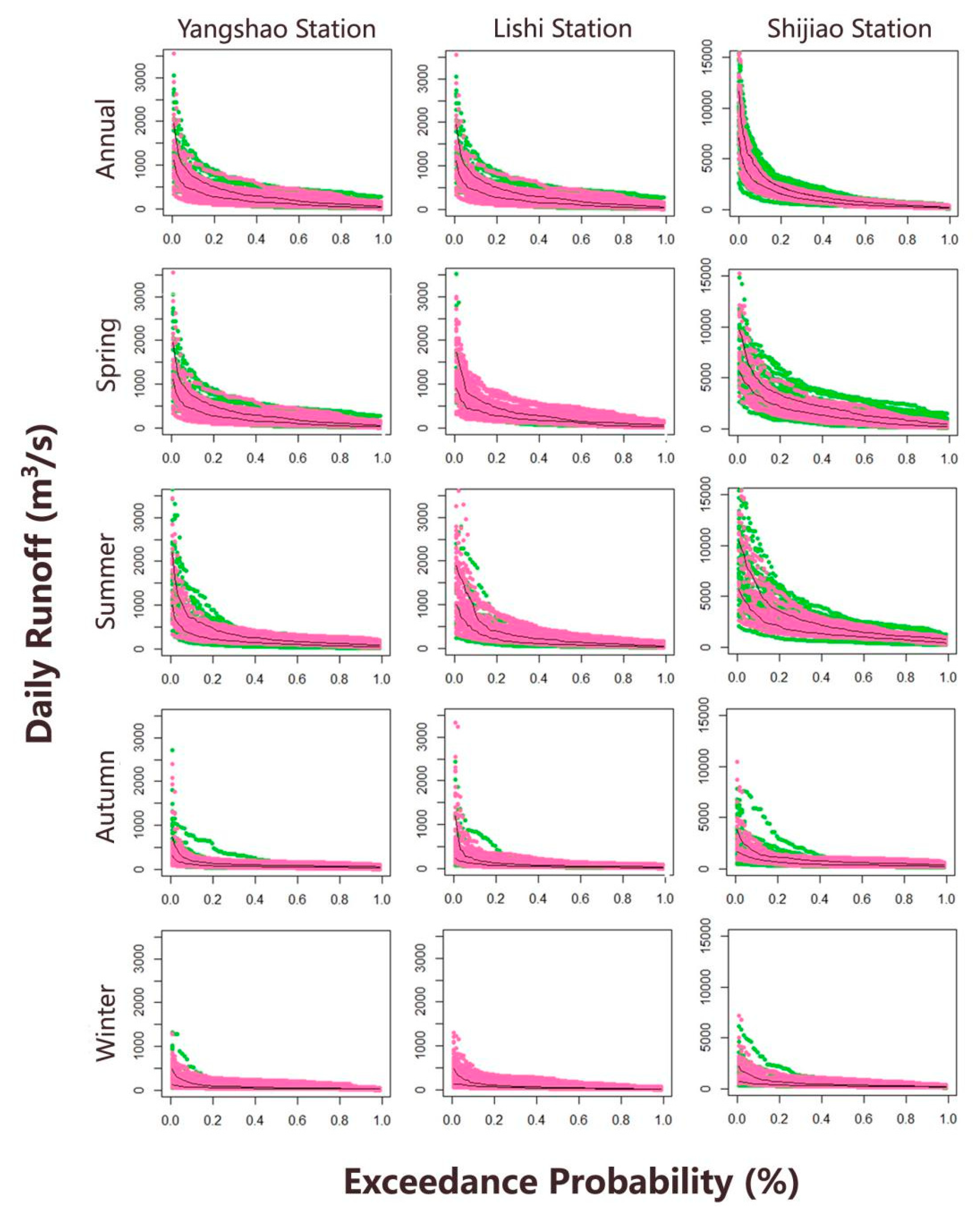
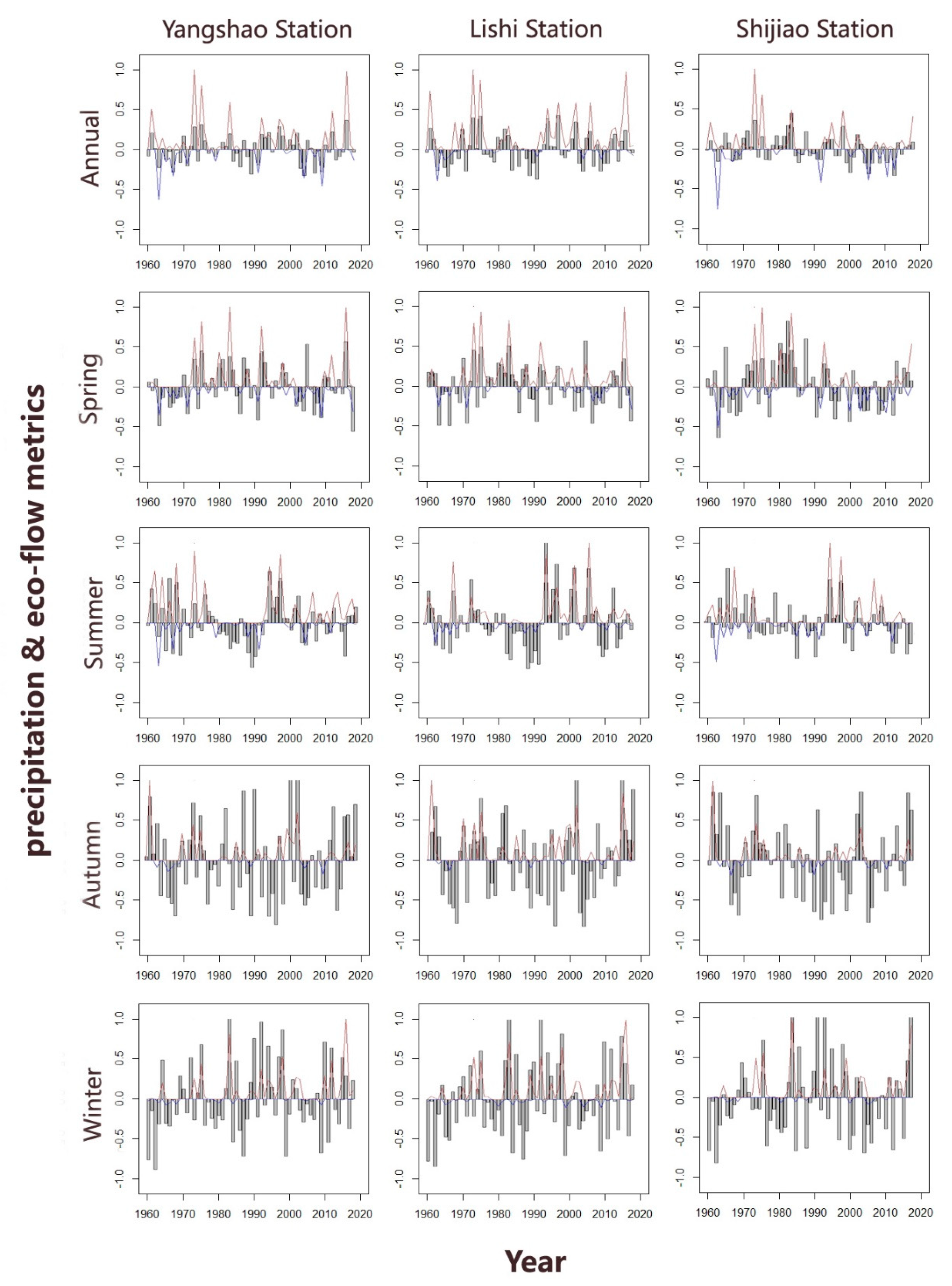

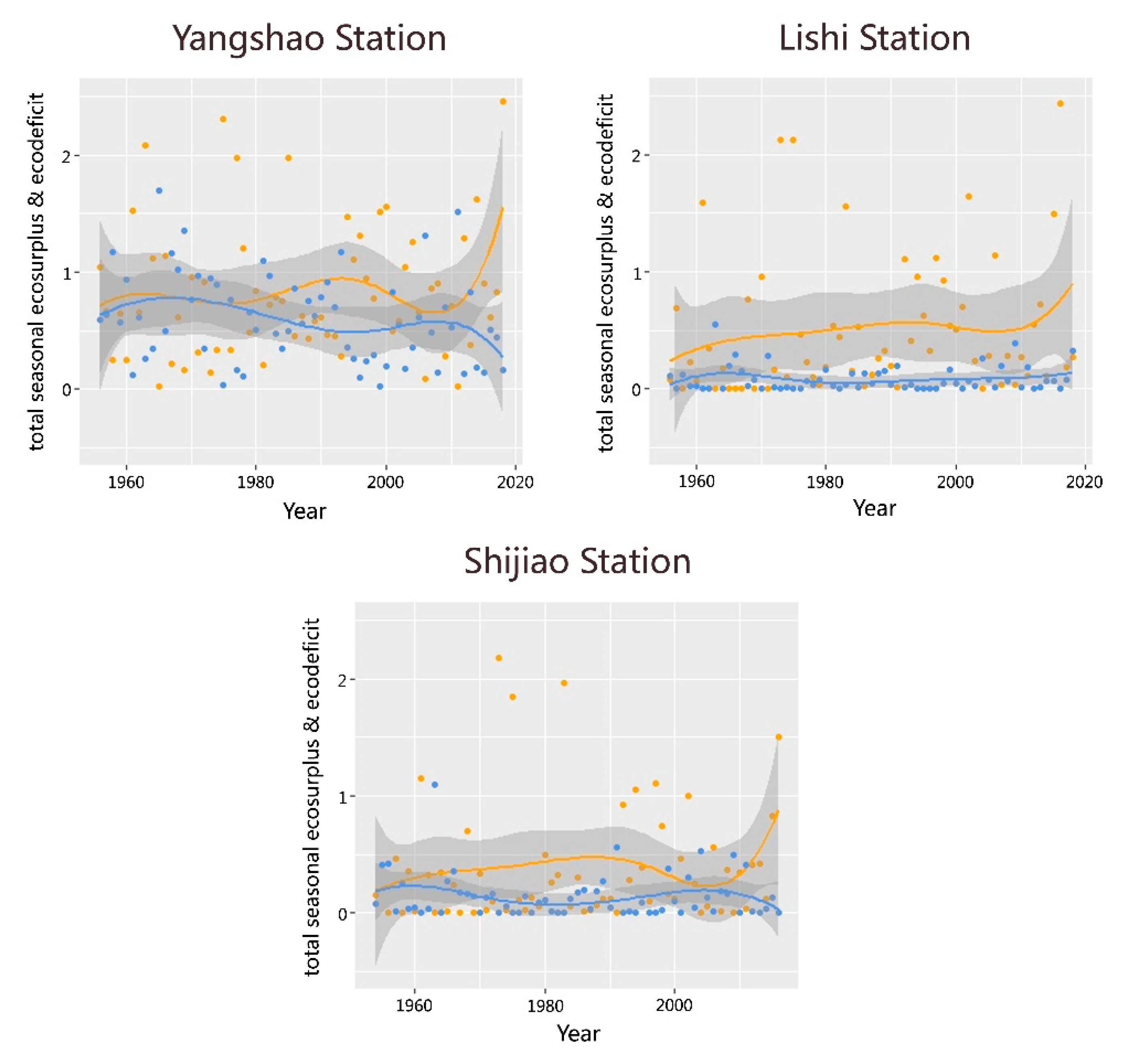
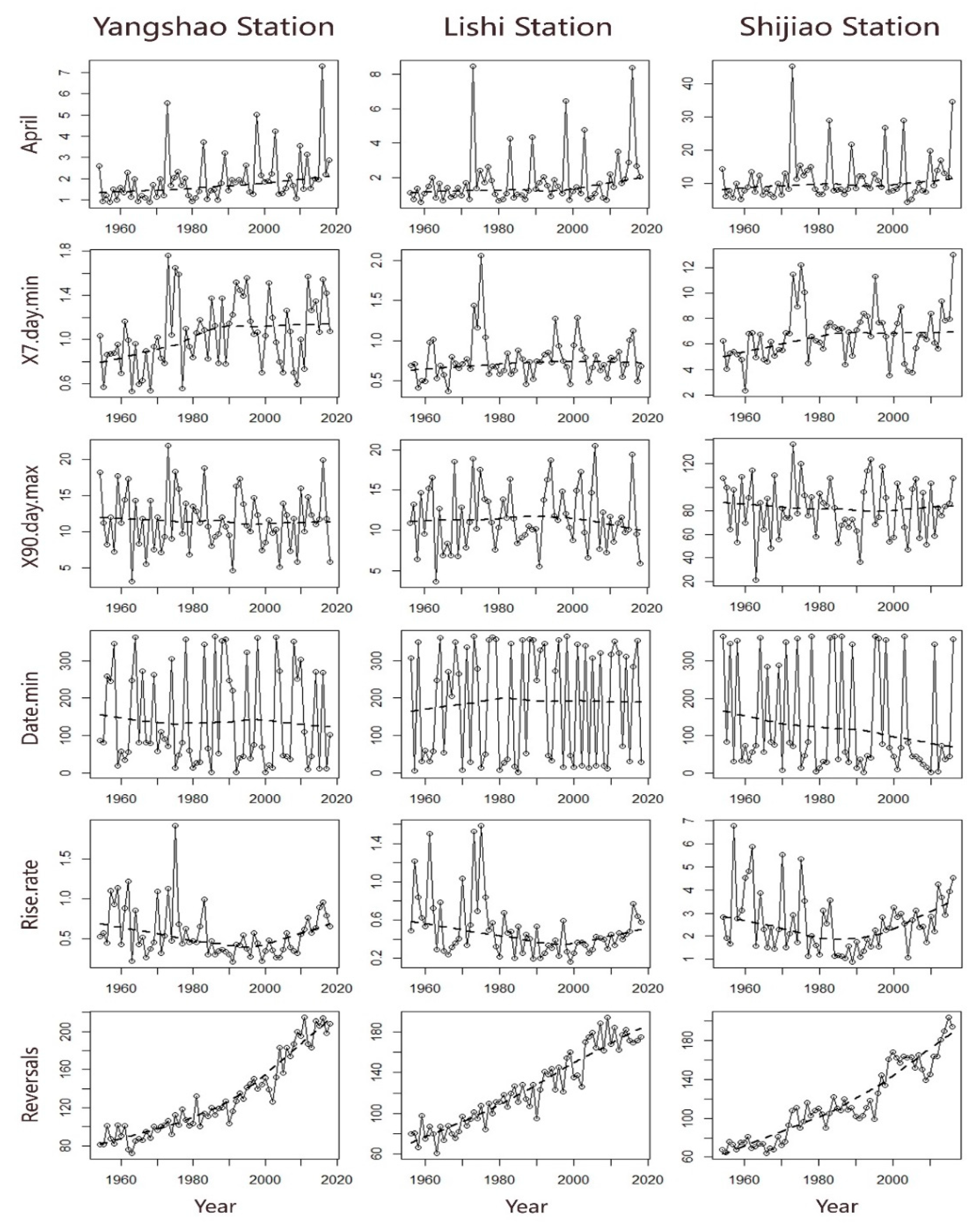
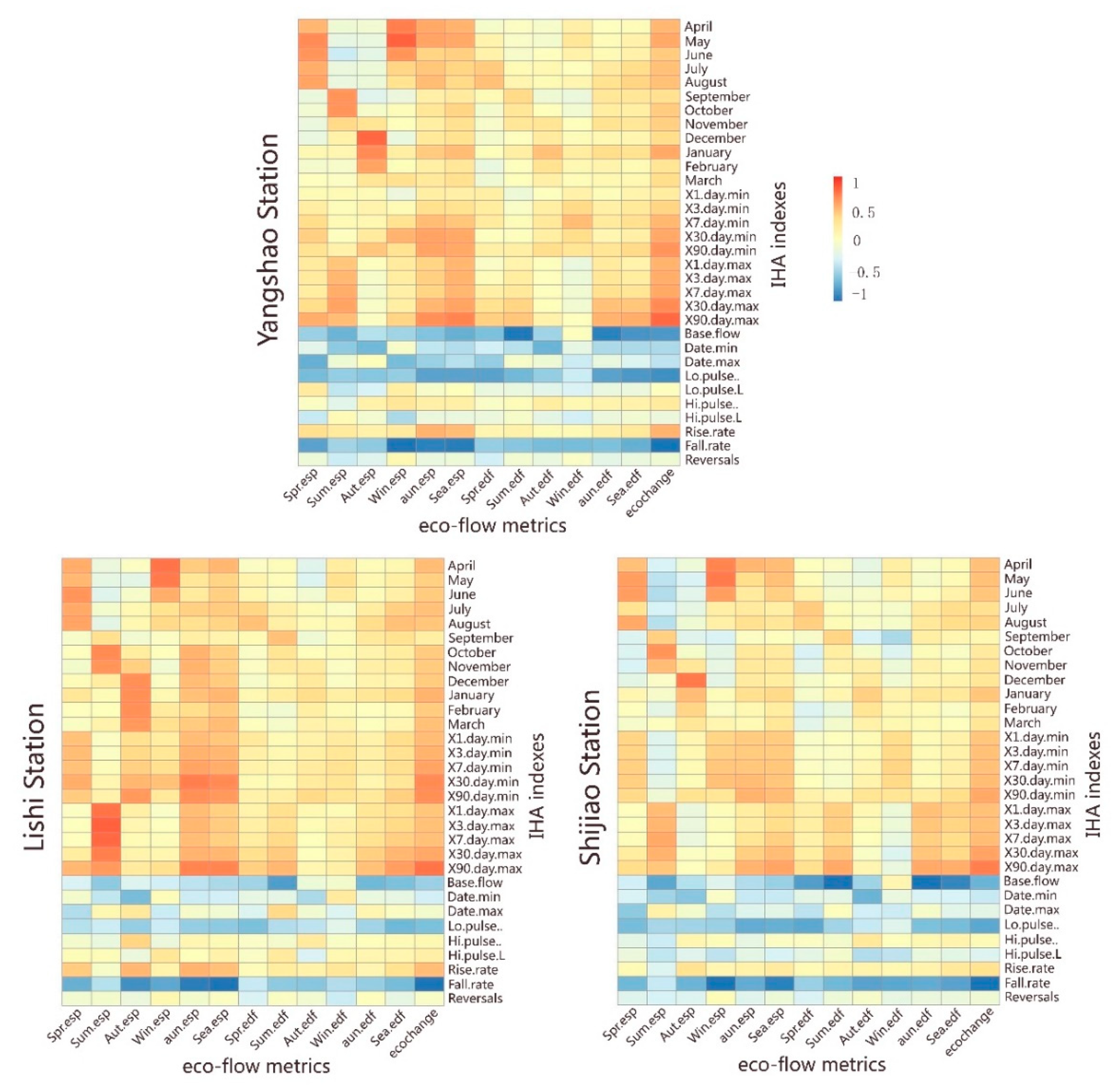
| River Basin | Beijiang River | Zhenjiang River | Wujiang River |
|---|---|---|---|
| Drainage area (km2) | 46710 | 7554 | 7097 |
| Length (km) | 468 | 211 | 260 |
| Runoff (×109 m3) | 42.9 | 5.91 | 6.08 |
| Main reservoir (other reservoirs) | Feilaixia reservoir | Jinjiang reservoir | Lechangxia reservoir (Changhe reservoir, Xiniutan reservoir, Muxi reservoir) |
| Hydrological station at the outlet | Shijiao Station | Yangshao Station | Lishi Station |
| Data covering period | 1952–2016 | 1954–2018 | 1956–2018 |
| Dividing year | 1999 | 1993 | 1972 |
| IHA Parameter Group (Subtotal Number) | Hydrologic Parameters | Impacts on the Ecosystem |
|---|---|---|
| Magnitude of monthly water conditions (12) | Median value for each calendar month | Affect the availability of water (including habitat and water use) by affecting hydrology, oxygen content and water column photosynthesis |
| Magnitude and durationof annual extreme water conditions (12) | Annual minima 1-day means | Affect the competitive balance between organisms, anaerobic capacity and so on by affecting the morphological structure of river channels, the ventilation of river sediments, the conditions of natural habitats and the construction of aquatic ecosystems, thereby |
| Annual minima 3-day means | ||
| Annual minima 7-day means | ||
| Annual minima 30-day means | ||
| Annual minima 90-day means | ||
| Annual maxima 1-day means | ||
| Annual maxima 3-day means | ||
| Annual maxima 7-day means | ||
| Annual maxima 30-day means | ||
| Annual maxima 90-day means | ||
| Zero-flow days | ||
| Base flow index | ||
| Timing of annual extreme water conditions (2) | Julian date of each annual 1 day maximum | Affects the species’ behavior mechanism (such as fish spawning) by affecting the compatibility with their life cycle |
| Julian date of each annual 1 day maximum | ||
| Frequency and duration of high and low pulses (4) | Number of high pulse | Affects the stability of sediments and substrates by affecting water stress, thereby affecting the floodplain habitat of aquatic organisms |
| Number of low pulse | ||
| Mean duration of high pulse | ||
| Mean duration of low pulse | ||
| Rate and frequency of water condition changes (3) | Rise rates | Affects the drought pressure of the organisms (mainly plants) by affecting the rise and fall of the water levels |
| Fall rates | ||
| Number of hydrologic reversals |
| IHA Indicators | Changing Rates of the IHA Indicators of Prior and Posterior NUMERICAL Value (%) | ||
|---|---|---|---|
| Yangshao | Lishi | Shijiao | |
| April | −1.116 | 21.303 | −6.521 |
| May | −4.719 | 15.877 | −5.164 |
| June | −3.804 | −3.562 | −3.900 |
| July | 45.230 | 52.803 | 5.042 |
| August | 44.554 | 27.826 | 6.188 |
| September | 9.819 | 3.553 | −9.722 |
| October | 27.712 | 16.508 | −2.388 |
| November | 17.123 | 18.531 | 9.659 |
| December | 58.060 | 22.047 | 37.504 |
| January | 40.780 | 80.734 | 13.567 |
| February | 28.166 | 15.999 | −1.231 |
| March | 8.924 | 48.902 | −15.830 |
| 1-day min | −31.394 | −0.748 | 0.350 |
| 3-day min | −11.572 | 13.121 | 4.217 |
| 7-day min | 10.804 | 21.074 | 6.160 |
| 30-day min | 33.148 | 34.107 | 19.398 |
| 90-day min | 18.470 | 19.216 | 3.124 |
| 1-day max | −3.288 | 14.968 | 14.652 |
| 3-day max | −7.794 | 13.059 | 12.146 |
| 7-day max | −7.804 | 7.396 | 6.911 |
| 30-day max | −9.399 | 3.291 | −2.711 |
| 90-day max | −5.216 | 10.656 | −1.973 |
| Base flow | 2.871 | −1.577 | 4.598 |
| Date min | −6.560 | 10.645 | −38.251 |
| Date max | 11.788 | −7.940 | −0.062 |
| Low pulse | 93.957 | 22.826 | 165.308 |
| Low pulse Duration | −74.808 | −59.707 | −77.624 |
| High pulse | 8.697 | −0.447 | 20.676 |
| High pulse Duration | 6.054 | −1.595 | −38.725 |
| Rise rate | −16.545 | −25.618 | 18.103 |
| Fall rate | 78.175 | 39.217 | 90.607 |
| Reversals | 68.921 | 69.841 | 73.196 |
| Yangshao Station | Lishi Station | Shijiao Station | |
|---|---|---|---|
| PC1 | April | April | April |
| PC2 | 90-day max | Rise rate | 90-day min |
| PC3 | 7-day min | 30-day min | Rise rate |
| PC4 | Low pulse Duration | Date min | High pulse |
| PC5 | High pulse Duration | 90-day max | Date min |
| PC6 | Reversals | Reversals | 90-day max |
| PC7 | Fall rate | Low pulse | High pulse Duration |
| Stations | IHA Subgroups | Mean Changing (%) | Impact Points | Total Points | Do (%) | ||
|---|---|---|---|---|---|---|---|
| Means | CV | Means | CV | ||||
| Yangshao | 1 | 22.561 | 6.803 | 1 | 0 | 1(2) | 37.629775 |
| 2 | 1.016 | 5.270 | 0 | 0 | |||
| 3 | 2.614 | 13.336 | 0 | 0 | |||
| 4 | 8.475 | 7.831 | 0 | 0 | |||
| 5 | 43.517 | 5.061 | 0 | 0 | |||
| Lishi | 1 | 26.710 | 24.886 | 1 | 0 | 1(2) | 30.425076 |
| 2 | 12.233 | 17.693 | 0 | 0 | |||
| 3 | 1.352 | 13.992 | 0 | 0 | |||
| 4 | 9.731 | 0.251 | 0 | 0 | |||
| 5 | 27.813 | 21.716 | 0 | 0 | |||
| Shijiao | 1 | 2.267 | 9.179 | 0 | 0 | 2(2) | 36.49904 |
| 2 | 6.079 | 8.737 | 0 | 0 | |||
| 3 | 19.157 | 32.765 | 1 | 0 | |||
| 4 | 17.409 | 4.972 | 0 | 0 | |||
| 5 | 60.635 | 42.685 | 1 | 0 | |||
| Month | Yangshao Station | Lishi Station | Shijiao Station | |||
|---|---|---|---|---|---|---|
| Save | Seco | Save | Seco | Save | Seco | |
| January | 1.96 | 1.09 | 1.83 | 1.16 | 11.58 | 6.54 |
| February | 2.39 | 1.16 | 2.50 | 0.83 | 14.15 | 6.14 |
| March | 3.71 | 0.83 | 3.98 | 1.07 | 22.09 | 3.98 |
| April | 6.33 | 2.91 | 6.84 | 3.23 | 43.98 | 17.61 |
| May | 8.43 | 2.50 | 8.40 | 3.06 | 66.56 | 33.58 |
| June | 9.31 | 1.48 | 8.27 | 1.16 | 71.81 | 25.34 |
| July | 5.19 | 2.65 | 4.54 | 2.49 | 41.74 | 18.40 |
| August | 4.31 | 2.03 | 4.28 | 1.96 | 35.62 | 18.17 |
| September | 3.32 | 1.61 | 3.25 | 0.95 | 25.47 | 13.34 |
| October | 2.65 | 1.54 | 2.16 | 1.04 | 16.17 | 7.58 |
| November | 2.23 | 1.17 | 1.96 | 0.77 | 14.03 | 6.77 |
| December | 1.98 | 1.31 | 1.67 | 0.76 | 11.68 | 7.24 |
| Abbreviation | Description | Abbreviation | Description |
|---|---|---|---|
| Spr | Spring | X30.day.min | minimum 30-day runoff |
| Sum | Summer | X90.day.max | maximum 90-day runoff |
| Aut | Autumn | Date.min | time of minimum daily runoff occurs |
| Win | Winter | Date.max | time of maximum daily runoff occurs |
| Aun | annual | Lo.pulse. | low pulse count |
| Sea | Total seasonal | Lo.pulse.L | low pulse duration |
| Esp | ecosurplus | Hi.pulse. | high pulse count |
| Edf | ecodeficit | Hi.pulse.L | high pulse duration |
| Ecochange | Total seasonal ecosurplus and ecodeficit | ||
© 2020 by the authors. Licensee MDPI, Basel, Switzerland. This article is an open access article distributed under the terms and conditions of the Creative Commons Attribution (CC BY) license (http://creativecommons.org/licenses/by/4.0/).
Share and Cite
Du, J.; Wu, X.; Wang, Z.; Li, J.; Chen, X. Reservoir-Induced Hydrological Alterations Using Ecologically Related Hydrologic Metrics: Case Study in the Beijiang River, China. Water 2020, 12, 2008. https://doi.org/10.3390/w12072008
Du J, Wu X, Wang Z, Li J, Chen X. Reservoir-Induced Hydrological Alterations Using Ecologically Related Hydrologic Metrics: Case Study in the Beijiang River, China. Water. 2020; 12(7):2008. https://doi.org/10.3390/w12072008
Chicago/Turabian StyleDu, Jiakai, Xushu Wu, Zhaoli Wang, Jun Li, and Xiaohong Chen. 2020. "Reservoir-Induced Hydrological Alterations Using Ecologically Related Hydrologic Metrics: Case Study in the Beijiang River, China" Water 12, no. 7: 2008. https://doi.org/10.3390/w12072008
APA StyleDu, J., Wu, X., Wang, Z., Li, J., & Chen, X. (2020). Reservoir-Induced Hydrological Alterations Using Ecologically Related Hydrologic Metrics: Case Study in the Beijiang River, China. Water, 12(7), 2008. https://doi.org/10.3390/w12072008







